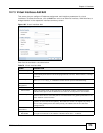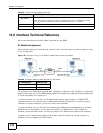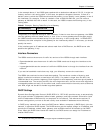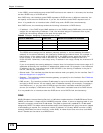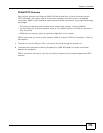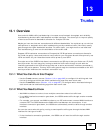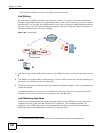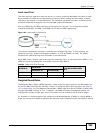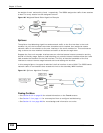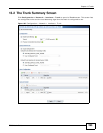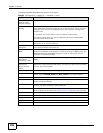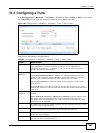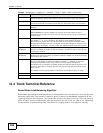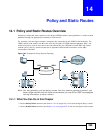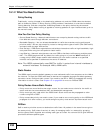
Chapter 13 Trunks
ISG50 User’s Guide
283
Least Load First
The least load first algorithm uses the current (or recent) outbound bandwidth utilization of each
trunk member interface as the load balancing index(es) when making decisions about to which
interface a new session is to be distributed. The outbound bandwidth utilization is defined as the
measured outbound throughput over the available outbound bandwidth.
Here the ISG50 has two WAN interfaces connected to the Internet. The configured available
outbound bandwidths for WAN 1 and WAN 2 are 512K and 256K respectively.
Figure 189 Least Load First Example
The outbound bandwidth utilization is used as the load balancing index. In this example, the
measured (current) outbound throughput of WAN 1 is 412K and WAN 2 is 198K. The ISG50
calculates the load balancing index as shown in the table below.
Since WAN 2 has a smaller load balancing index (meaning that it is less utilized than WAN 1), the
ISG50 will send the subsequent new session traffic through WAN 2.
Weighted Round Robin
The Weighted Round Robin (WRR) algorithm is best suited for situations when the bandwidths set
for the two WAN interfaces are different. Similar to the Round Robin (RR) algorithm (see Section
13.4 on page 288), the The Weighted Round Robin (WRR) algorithm sets the ISG50 to send traffic
through each WAN interface in turn. In addition, the WAN interfaces are assigned weights. An
interface with a larger weight gets more of the traffic than an interface with a smaller weight.
For example, in the figure below, the configured available bandwidth of WAN1 is 1M and WAN2 is
512K. You can set the ISG50 to distribute the network traffic between the two interfaces by setting
Table 83 Least Load First Example
INTERFACE
OUTBOUND
LOAD BALANCING INDEX
(M/A)
AVAILABLE (A) MEASURED (M)
WAN 1 512 K 412 K 0.8
WAN 2 256 K 198 K 0.77
ISG



